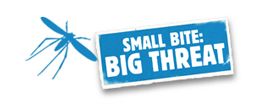Vector Control Bill Brieger | 06 Apr 2014 11:30 pm
Vexing Vector Visualizations on World Health Day
 This year World Health Day (April 7th) focuses on insect vectors of disease with the theme “small bite, big threat.” WHO explains that, “Mosquitoes, flies, ticks and bugs may be a threat to your health – and that of your family – at home and when travelling. This is the message of this year’s World Health Day.” Furthermore “Every year, more than 1 billion people are infected and more than 1 million die from vector-borne diseases.”
This year World Health Day (April 7th) focuses on insect vectors of disease with the theme “small bite, big threat.” WHO explains that, “Mosquitoes, flies, ticks and bugs may be a threat to your health – and that of your family – at home and when travelling. This is the message of this year’s World Health Day.” Furthermore “Every year, more than 1 billion people are infected and more than 1 million die from vector-borne diseases.”
While we are happy about this world-wide attention to disease vectors in general, at Malaria Matters we are particularly concerned with the various anopheles mosquitoes that carry malaria parasites. Thus it is time to vent a little frustration with the media that visually sends the wrong message about mosquitoes and malaria.
First we can see a typical news story on our first screen shot that presents an article about malaria with a photo of Aedes aeqypti mosquitoes that carry dengue and yellow fever. While one can agree that this black and white striped mosquito is a bit scarier and attention grabbing than a blander colored anopheles, it still gives wrong information and wrong ideas. The two mosquitoes have very different biting and breeding and patterns that lead to very different control interventions.
 Granted, the general public might not distinguish among the various nuisances called mosquitoes, but at least professionals aiming to communicate information about malaria should research and present the correct graphics. Fortunately we can rely on the US Centers for Disease Control and Prevention to help us distinguish our mosquitoes.
Granted, the general public might not distinguish among the various nuisances called mosquitoes, but at least professionals aiming to communicate information about malaria should research and present the correct graphics. Fortunately we can rely on the US Centers for Disease Control and Prevention to help us distinguish our mosquitoes.
Another concern with the media is a stress on malaria control interventions that may not be the major focus of key international programs that are part of the Roll Back Malaria (RBM) Partnership. RBM and partners set sights on three main malaria interventions at the onset – insecticide treated bed nets (ITNs), prompt and appropriate malaria case management, and intermittent preventive treatment (IPT) for pregnant women. WHO offers guidance on each of these interventions that donors like the Global Fund and the US President’s Malaria Initiative follow in making their funding decisions.
Malaria control has expanded cautiously from the three core interventions to include indoor residual spraying (IRS) in epidemiologically appropriate settings. Larviciding under restricted conditions is now included to round out an integrated vector control strategy. Also the concept of IPT was tested with infants and children and has now become the strategy of seasonal malaria chemoprevention (SMC) in countries of the Sahel. These additions have come after rigorous scientific testing and with an eye to the economic costs and benefits of supporting scale up.
Ironically, some media outlets and city councils get fixated on outdoor spraying or fogging (as seen in photo). This is NOT a RBM strategic intervention for a number of reasons. INDOOR residual spraying is designed specifically with the behavior of anopheles in mind because they do rest on the walls inside houses after biting and residual means the insecticidal effect lasts for some months. OUTDOOR fogging is hit and miss and dissipates.
So in conclusion we hope people will use today’s World Health Day focus on vector borne diseases to give a nod to the Pan-African Mosquito Control Association and to get to know their mosquitoes and mosquito interventions better.

